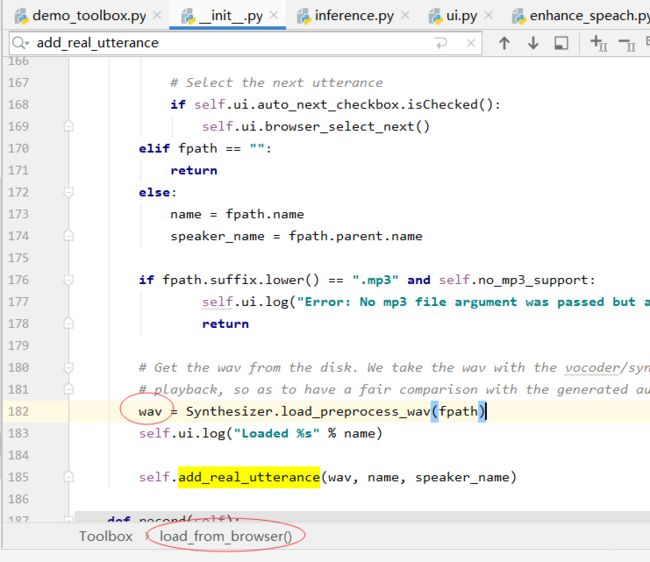一.处理源语音
1.定位:
2.仿造load_preprocess_wav()函数读入音频
3.新建enhance.py文件,主要使用减谱法和自适应滤波器法,代码如下:
#!/usr/bin/env python
import librosa
import numpy as np
import wave
import math
from synthesizer.hparams import hparams
import os
import ctypes as ct
from encoder import inference as encoder
from utils import logmmse
#减谱法:通过发生前所谓的“寂静段”(认为在这一段里没有语音只有噪声)来估计噪声的功率谱。从带噪语音的功率谱中减去噪声功率谱
#自适应滤波器法:实现带噪信号中的噪声估计,并用原始信号减去估计值
def enhance(fpath):
class FloatBits(ct.Structure):
_fields_ = [
('M', ct.c_uint, 23),
('E', ct.c_uint, 8),
('S', ct.c_uint, 1)
]
class Float(ct.Union):
_anonymous_ = ('bits',)
_fields_ = [
('value', ct.c_float),
('bits', FloatBits)
]
def nextpow2(x):
if x < 0:
x = -x
if x == 0:
return 0
d = Float()
d.value = x
if d.M == 0:
return d.E - 127
return d.E - 127 + 1
# 打开WAV文档
f = wave.open(str(fpath))
# 读取格式信息
# (nchannels, sampwidth, framerate, nframes, comptype, compname)
params = f.getparams()
nchannels, sampwidth, framerate, nframes = params[:4]
fs = framerate
# 读取波形数据
str_data = f.readframes(nframes)
f.close()
# 将波形数据转换为数组
x = np.fromstring(str_data, dtype=np.short)
# 计算参数
len_ = 20 * fs // 1000 # 样本中帧的大小
PERC = 50 # 窗口重叠占帧的百分比
len1 = len_ * PERC // 100 # 重叠窗口
len2 = len_ - len1 # 非重叠窗口
# 设置默认参数
Thres = 3
Expnt = 2.0
beta = 0.002
G = 0.9
# 初始化汉明窗
win = np.hamming(len_)
# normalization gain for overlap+add with 50% overlap
winGain = len2 / sum(win)
# Noise magnitude calculations - assuming that the first 5 frames is noise/silence
nFFT = 2 * 2 ** (nextpow2(len_))
noise_mean = np.zeros(nFFT)
j = 0
for k in range(1, 6):
noise_mean = noise_mean + abs(np.fft.fft(win * x[j:j + len_], nFFT))
j = j + len_
noise_mu = noise_mean / 5
# --- allocate memory and initialize various variables
k = 1
img = 1j
x_old = np.zeros(len1)
Nframes = len(x) // len2 - 1
xfinal = np.zeros(Nframes * len2)
# ========================= Start Processing ===============================
for n in range(0, Nframes):
# Windowing
insign = win * x[k-1:k + len_ - 1]
# compute fourier transform of a frame
spec = np.fft.fft(insign, nFFT)
# compute the magnitude
sig = abs(spec)
# save the noisy phase information
theta = np.angle(spec)
SNRseg = 10 * np.log10(np.linalg.norm(sig, 2) ** 2 / np.linalg.norm(noise_mu, 2) ** 2)
def berouti(SNR):
if -5.0 <= SNR <= 20.0:
a = 4 - SNR * 3 / 20
else:
if SNR < -5.0:
a = 5
if SNR > 20:
a = 1
return a
def berouti1(SNR):
if -5.0 <= SNR <= 20.0:
a = 3 - SNR * 2 / 20
else:
if SNR < -5.0:
a = 4
if SNR > 20:
a = 1
return a
if Expnt == 1.0: # 幅度谱
alpha = berouti1(SNRseg)
else: # 功率谱
alpha = berouti(SNRseg)
#############
sub_speech = sig ** Expnt - alpha * noise_mu ** Expnt;
# 当纯净信号小于噪声信号的功率时
diffw = sub_speech - beta * noise_mu ** Expnt
# beta negative components
def find_index(x_list):
index_list = []
for i in range(len(x_list)):
if x_list[i] < 0:
index_list.append(i)
return index_list
z = find_index(diffw)
if len(z) > 0:
# 用估计出来的噪声信号表示下限值
sub_speech[z] = beta * noise_mu[z] ** Expnt
# --- implement a simple VAD detector --------------
if SNRseg < Thres: # Update noise spectrum
noise_temp = G * noise_mu ** Expnt + (1 - G) * sig ** Expnt # 平滑处理噪声功率谱
noise_mu = noise_temp ** (1 / Expnt) # 新的噪声幅度谱
# flipud函数实现矩阵的上下翻转,是以矩阵的“水平中线”为对称轴
# 交换上下对称元素
sub_speech[nFFT // 2 + 1:nFFT] = np.flipud(sub_speech[1:nFFT // 2])
x_phase = (sub_speech ** (1 / Expnt)) * (np.array([math.cos(x) for x in theta]) + img * (np.array([math.sin(x) for x in theta])))
# take the IFFT
xi = np.fft.ifft(x_phase).real
# --- Overlap and add ---------------
xfinal[k-1:k + len2 - 1] = x_old + xi[0:len1]
x_old = xi[0 + len1:len_]
k = k + len2
# 保存文件
wf = wave.open('out.wav', 'wb')
# 设置参数
wf.setparams(params)
# 设置波形文件 .tostring()将array转换为data
wave_data = (winGain * xfinal).astype(np.short)
wf.writeframes(wave_data.tostring())
wf.close()
wav = librosa.load("./out.wav", hparams.sample_rate)[0]
#再使用一次load_preprocess_wav()函数进行处理:在给定噪声配置文件(参考噪声)的情况下清除语音波形中的噪声。 波形必须有与用于创建噪声配置文件的采样率相同
if hparams.rescale:
wav = wav / np.abs(wav).max() * hparams.rescaling_max
# denoise(自适应滤波器法)
if len(wav) > hparams.sample_rate * (0.3 + 0.1):
noise_wav = np.concatenate([wav[:int(hparams.sample_rate * 0.15)],
wav[-int(hparams.sample_rate * 0.15):]])
profile = logmmse.profile_noise(noise_wav, hparams.sample_rate)
wav = logmmse.denoise(wav, profile)
# Trim excessive silences
wav = encoder.preprocess_wav(wav)
#删除保存的输出文件
os.remove("./out.wav")
return wav二.处理生成语音
1.定位:我选择在UI界面中的“Enhance vocoder output”中的槽函数中进行降噪处理
2.代码如下:
# Trim excessive silences
if self.ui.trim_silences_checkbox.isChecked():
#wav = encoder.preprocess_wav(wav)
sf.write('output.wav', wav, hparams.sample_rate) #先将变量wav写为文件的形式
wav = enhance('output.wav')
os.remove("./output.wav")三.处理录音音频
1.代码如下:
def record(self):
wav = self.ui.record_one(encoder.sampling_rate, 5)
sf.write('output1.wav', wav, hparams.sample_rate) # 先将变量wav写为文件的形式
wav = enhance('output1.wav')
os.remove("./output1.wav")
if wav is None:
return
self.ui.play(wav, encoder.sampling_rate)ps:python报错-AttributeError: module ‘librosa‘ has no attribute ‘output‘,解决报错参考办法网址:python报错-AttributeError: module ‘librosa‘ has no attribute ‘output‘